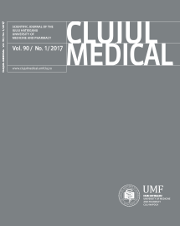Ultrasonographic evaluation of periodontal changes during orthodontic tooth movement - work in progress
DOI:
https://doi.org/10.15386/cjmed-663Keywords:
ultrasonography, periodontal tissue, orthodontic tooth movementAbstract
Background and aim. Orthodontic tooth movement (OTM) is a process whereby the application of a force induces bone resorption on the pressure side and bone apposition on the tension side of the lamina dura. However, only limited data are available on the in vivo behavior of the periodontal tissues. The aim of this study was to assess the changes of periodontal tissues, induced by the orthodontic canine retraction, using 40 MHz ultrasonography.
Methods. Ultrasonographic evaluation of periodontal tissues was conducted in 5 patients with indication for orthodontic treatment. The upper first premolars were extracted bilaterally due to severe crowding, and the canines were distalized using elastomeric chain with a net force of 100 cN. Ultrasonographic scans (US scans) were performed before, during and after retraction, in three distinct areas of the canines buccal surface: mesial, middle and distal. The reference point was the bracket, which appeared hyperechoic on the US scan. Four different dimensions were obtained: D1 (depth of the sulcus), D2 (thickness of the gingiva), D3 (length of the supracrestal fibers), D4 (width of periodontal space).
Results. An increase of D1 was observed in all three areas of the periodontium, during orthodontic treatment. D3 was strongly correlated before and immediately after force delivery only for the mesial area (r=0.828, p<0.05). In total, 228 variables were statistically analyzed using Pearson’s correlation coefficients, in order to demonstrate the relationship between periodontal findings during orthodontic tooth movement.
Conclusions. High-resolution ultrasonography has the capability to obviate changes in periodontal ligament space and free gingiva during orthodontic tooth movement.
Downloads
Additional Files
- Treatment mechanics after extraction of the premolars
- Position of the transducer
- Ultrasonic image of tooth 1.3
- Chart D1
- Chart D2
- Chart D3
- Chart D4
- Copyright assignment
- Declaration of conflict of interest
- Tabel I Average and SD of US measurements (mm)
- Tabel I Average and Standard deviation of US measurements (mm)
Published
How to Cite
Issue
Section
License
The authors are required to transfer the copyright of the published paper to the journal. This is done by agreeing to sign the Copyright Assignment Form. Whenever the case, authors are also required to send permissions to reproduce material (such as illustrations) from the copyright holder.

The papers published in the journal are licensed under a Creative Commons Attribution-NonCommercial-NoDerivatives 4.0 International License.

